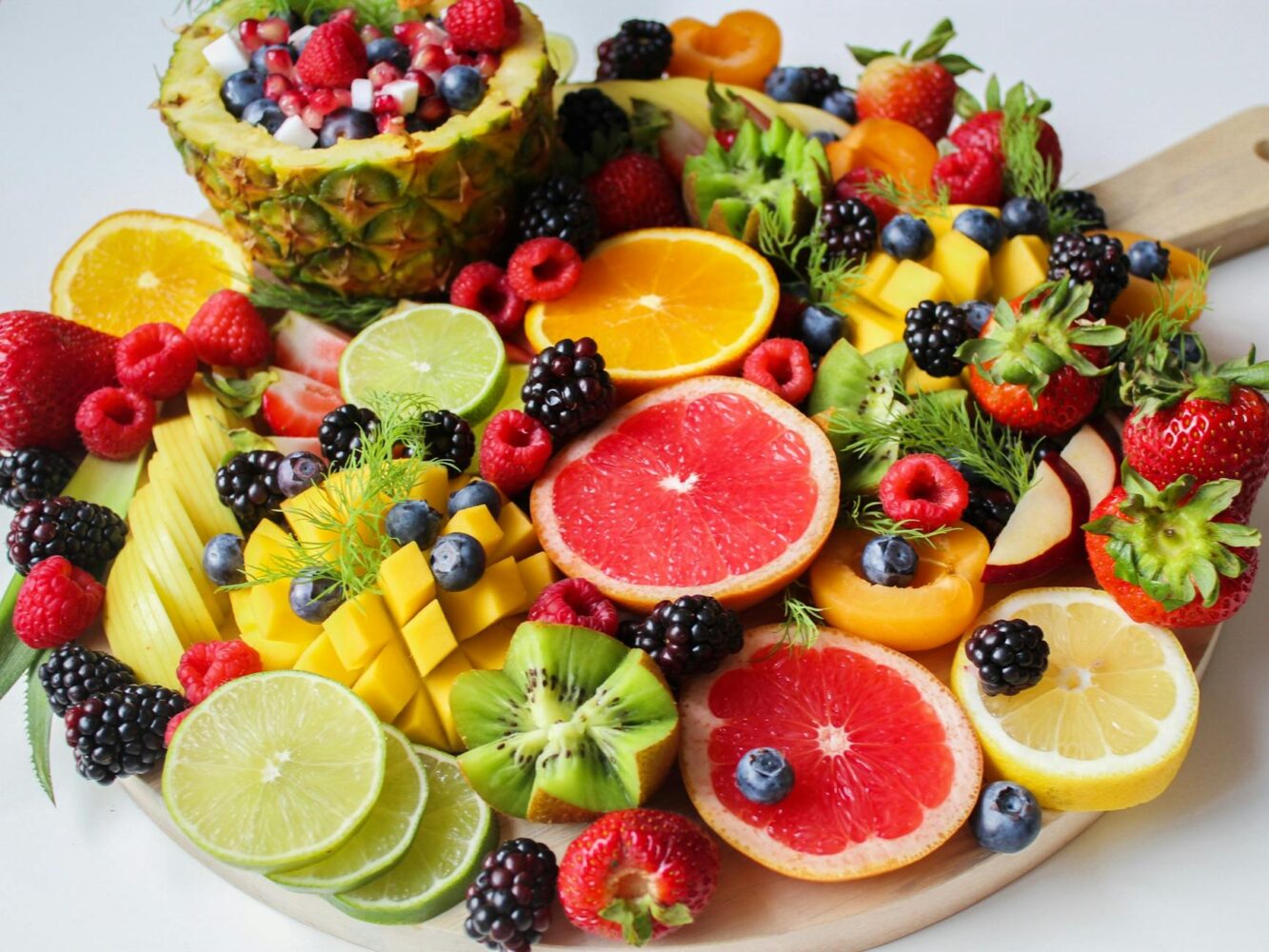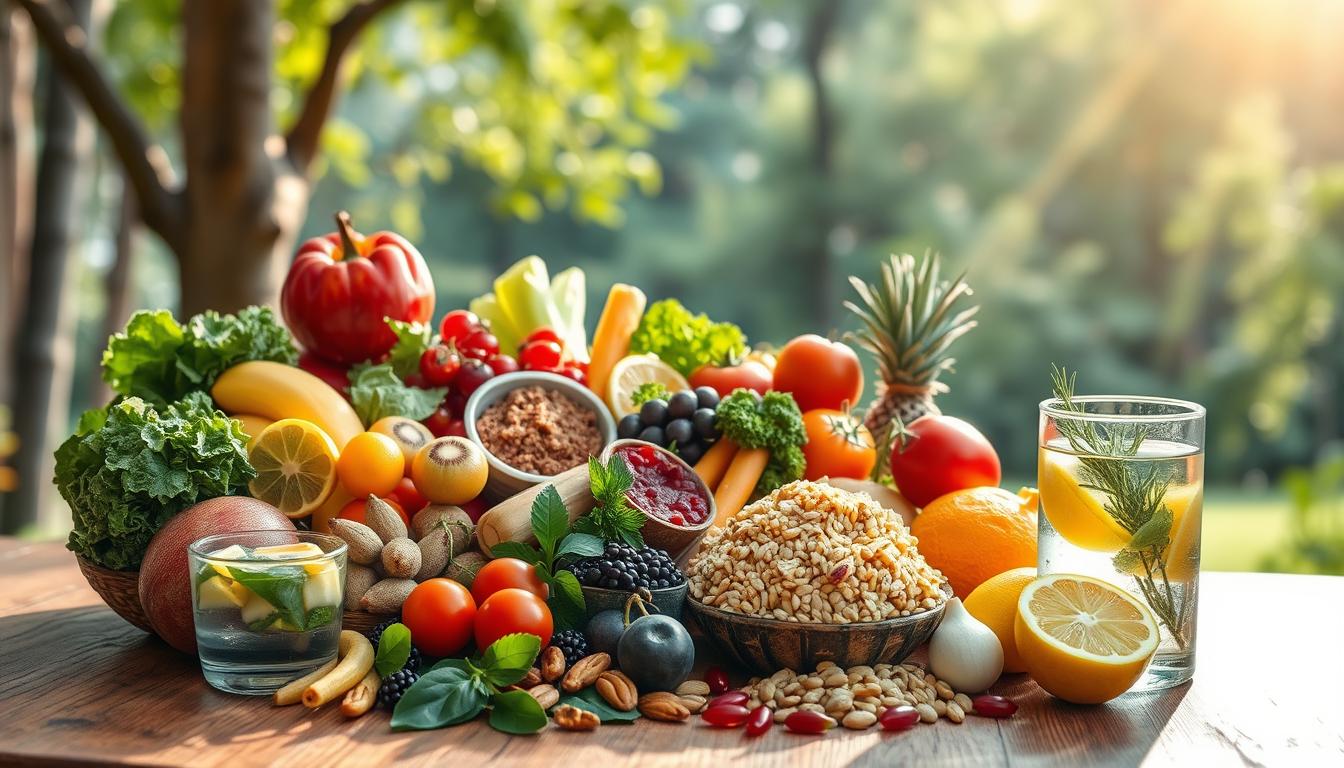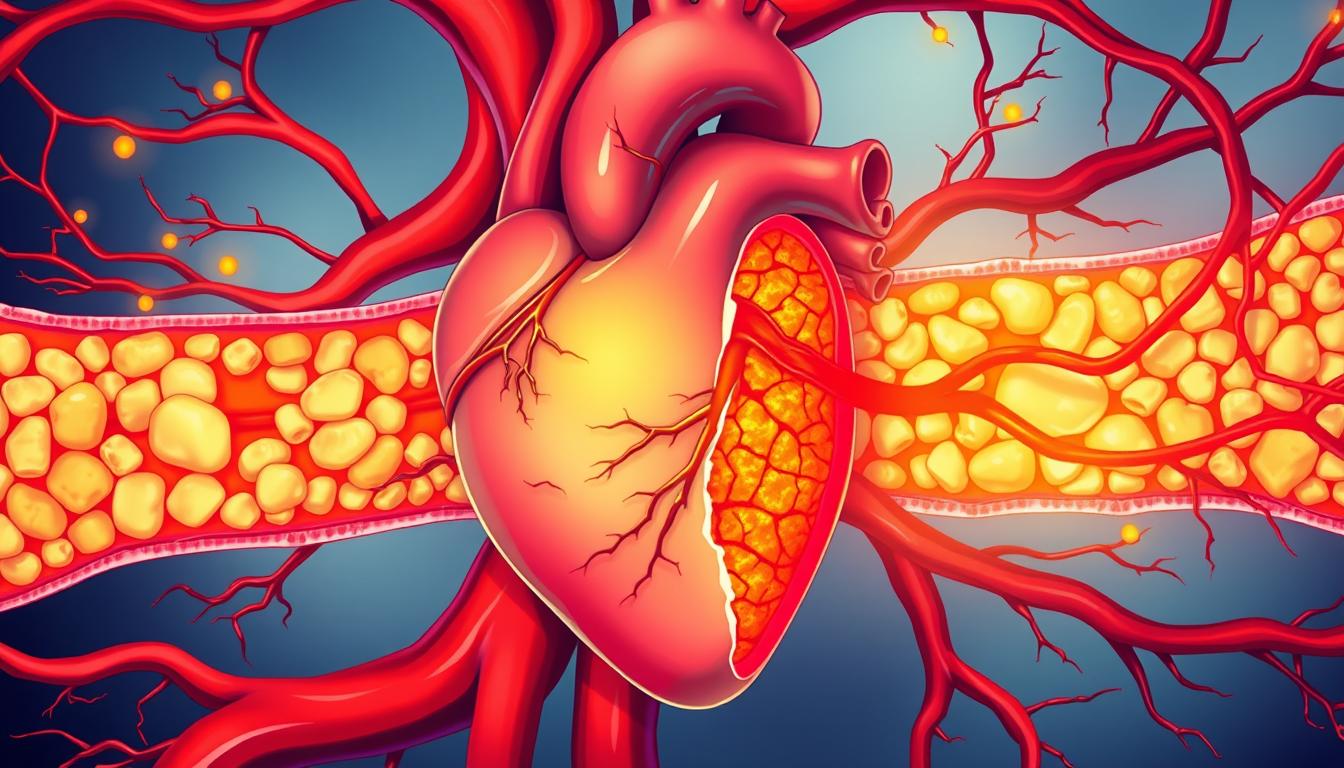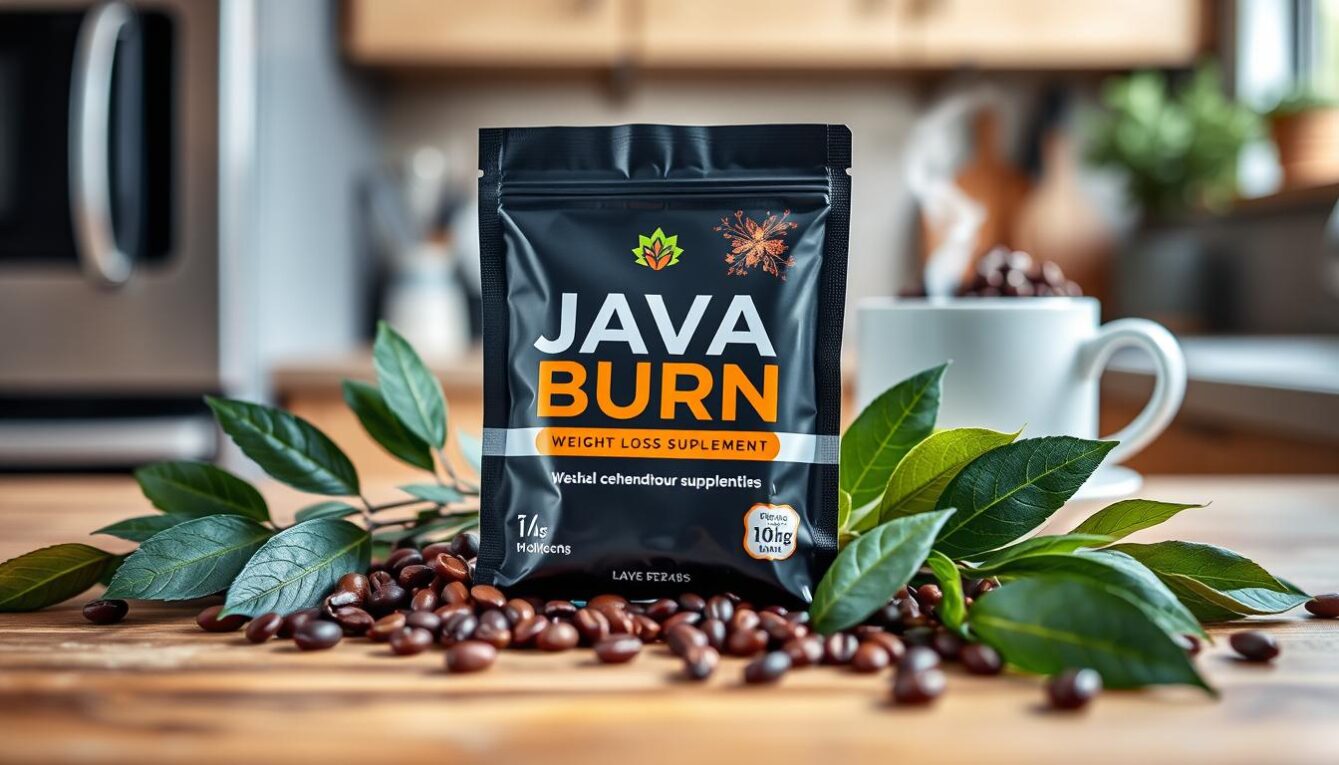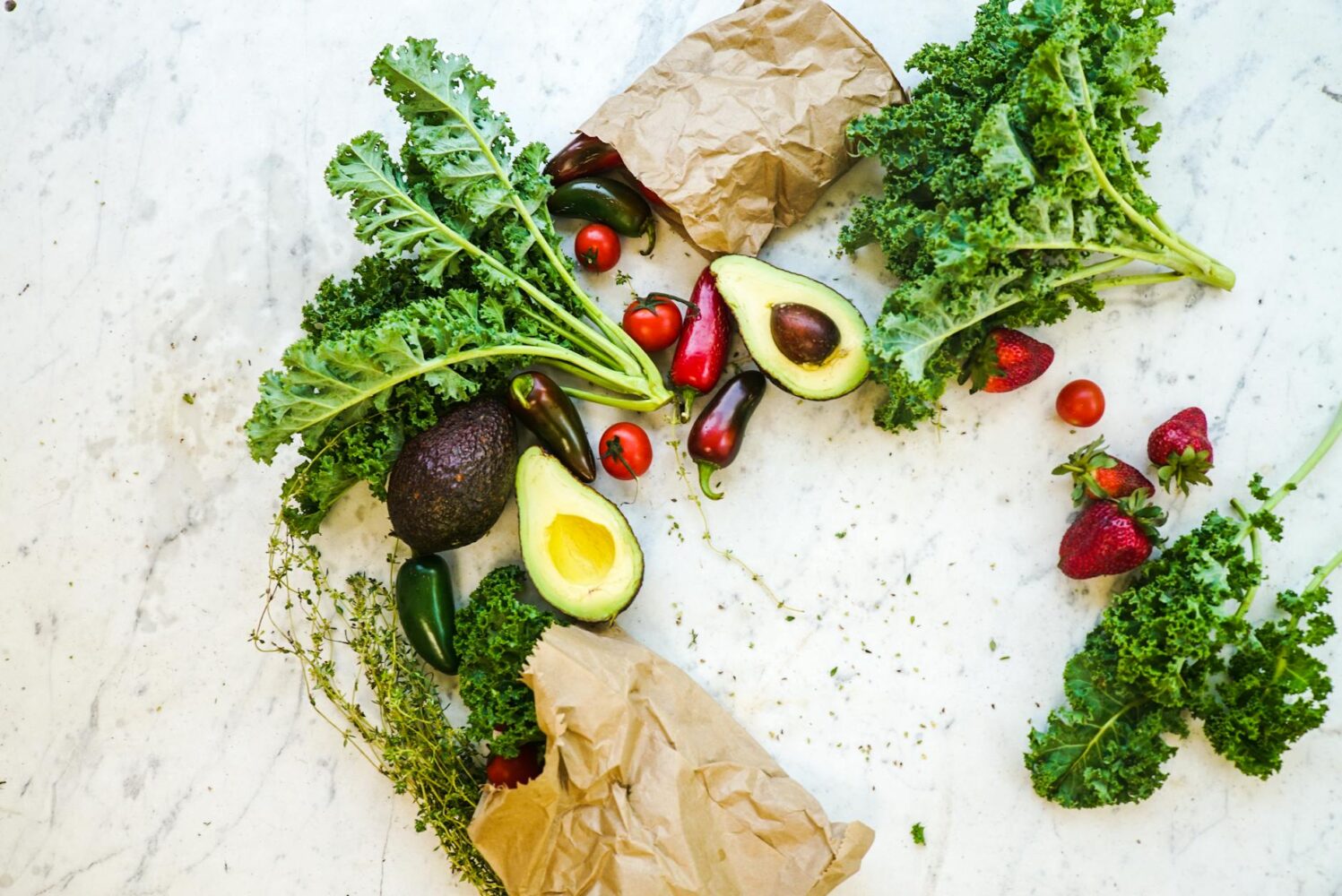Maintaining healthy blood vessels is crucial for overall health. Over 40 million Americans face circulatory issues, often linked to conditions like diabetes and obesity. A balanced diet plays a key role in improving circulation and preventing plaque buildup.
Studies show certain foods can enhance blood flow. For example, a 2022 study found curcumin improved circulation by 37%. Nitrates in foods like beets boost nitric oxide production, aiding vasodilation. Antioxidants and anti-inflammatory properties in berries and garlic also support vascular health.
Garlic supplementation has been shown to improve arm blood flow by 50%. These foods benefit both chronic patients and athletes, making them a valuable addition to any diet.
Key Takeaways
- Dietary choices significantly impact vascular health.
- Over 40 million Americans experience circulatory issues.
- Curcumin can improve circulation by 37%.
- Nitrates in beets enhance nitric oxide production.
- Garlic supplementation improves arm blood flow by 50%.
Introduction: Why Blood Flow Matters
Efficient blood flow ensures every organ functions optimally. It delivers oxygen and nutrients while removing waste products. Without proper circulation, the body struggles to maintain its balance.
Poor circulation can lead to symptoms like pain, numbness, and cold extremities. For example, 60% of patients with peripheral artery disease (PAD) experience leg cramps. These issues highlight the importance of maintaining vascular health.

Vascular diseases cost the U.S. economy $50 billion annually. Smoking, a major contributor, reduces circulation by 25%, according to NIH data. Lifestyle changes and dietary choices can make a significant difference.
Certain substances, like vasodilators, widen blood vessels to improve blood flow. In contrast, vasoconstrictors narrow them, potentially raising blood pressure. Understanding these mechanisms can help in managing circulation-related conditions.
Raynaud’s disease, affecting 5% of the population, is another example of circulation challenges. Proper health practices can also enhance cognitive function and speed up wound healing, making circulation a cornerstone of overall well-being.
1. Citrus Fruits: A Zesty Boost for Circulation
Adding citrus to your diet can work wonders for vascular health. These vibrant fruits are packed with nutrients that improve blood flow and protect blood vessels. From oranges to grapefruits, their benefits are backed by science.
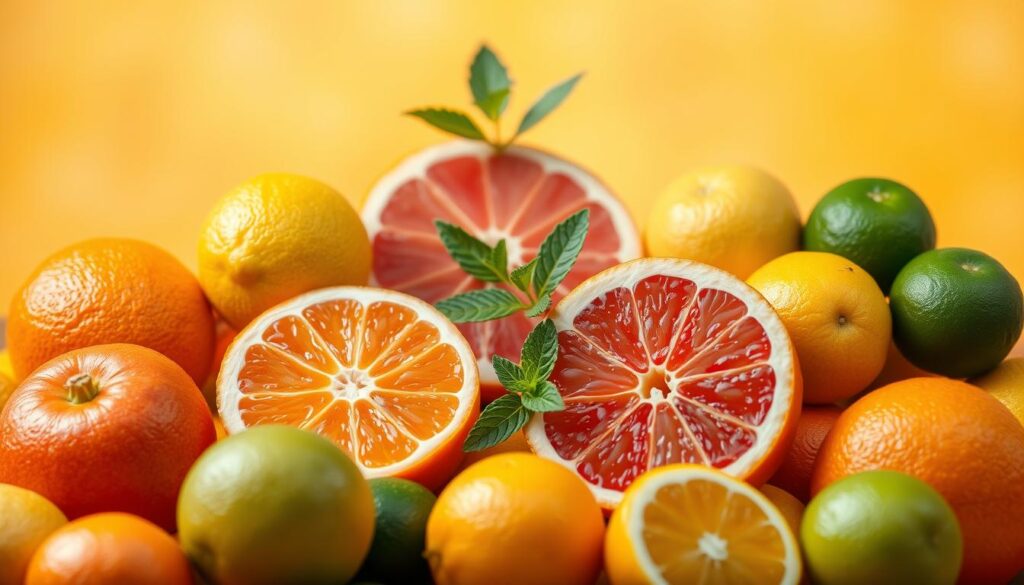
Rich in Vitamin C and Flavonoids
One orange provides 92% of your daily Vitamin C needs. This nutrient is essential for collagen production, which keeps blood vessels strong and flexible. A 2022 study found that oranges reduce arterial stiffness, enhancing circulation.
Flavonoids, like naringin in grapefruit, protect endothelial cells. These cells line your blood vessels, ensuring smooth blood flow. A 2018 JAMA study showed that flavonoids can reduce blood pressure by 12%.
Consuming whole citrus fruits is better than juice. The fiber content helps manage inflammation and supports overall heart health. However, grapefruit can interact with statins, so consult your doctor if you’re on medication.
“Citrus fruits have been a staple in diets for centuries, not just for their flavor but for their health benefits.”
| Citrus Fruit | Key Nutrient | Health Benefit |
|---|---|---|
| Orange | Vitamin C | Reduces arterial stiffness |
| Grapefruit | Naringin | Acts as a vasodilator |
| Lemon | Flavonoids | Protects endothelial cells |
Try a refreshing citrus and spinach salad drizzled with olive oil. This combo boosts nitric oxide production, aiding circulation. Historically, citrus fruits were used to prevent scurvy on long sea voyages, proving their lasting health value.
2. Leafy Greens: Nitrate Powerhouses
Incorporating leafy greens into your meals can significantly boost circulation. These vegetables are rich in nitrates, which convert into nitric oxide in the body. This compound helps relax blood vessels, improving vascular health and lowering blood pressure.
A Japanese study found that diets high in leafy greens are linked to lower hypertension rates. For example, 100g of spinach contains 250mg of nitrates. Other greens like arugula and kale also offer impressive nitrate levels, making them excellent choices for a heart-healthy diet.
Maximizing Nitrate Content
To preserve nitrates, avoid overcooking leafy greens. Steaming or sautéing them lightly retains more nutrients. Pairing these vegetables with vitamin C-rich foods, like citrus, can increase nitrate absorption by 20%.
Oxalate content is another consideration. While greens like spinach are nutrient-dense, they contain oxalates, which may affect some individuals. Moderation and variety are key to balancing benefits and potential drawbacks.
“Leafy greens are a cornerstone of a heart-healthy diet, offering both flavor and functional benefits.”
| Leafy Green | Nitrate Content (per 100g) | Health Benefit |
|---|---|---|
| Spinach | 250mg | Supports nitric oxide production |
| Arugula | 480mg | Promotes vasodilation |
| Kale | 180mg | Reduces arterial stiffness |
Dr. Greger’s Daily Dozen recommends at least one serving of leafy greens daily. Try blending them into green smoothies or sautéing with garlic for a flavorful side dish. USDA organic greens may have slightly higher nitrate levels, but both organic and conventional options are beneficial.
3. Berries: Antioxidant-Rich Superfoods
Packed with antioxidants, berries are a natural way to boost circulation. These colorful fruits are rich in anthocyanins, which improve endothelial function. This helps maintain flexible and healthy blood vessels.
One cup of blackberries provides 8g of fiber, aiding digestion and reducing inflammation. Studies show that wild blueberries have higher ORAC values than cultivated ones, meaning they offer more antioxidant power. Frozen berries retain most of their nutrients, making them a convenient option year-round.
A 2019 study in the Circulation Journal found that regular berry consumption reduces the risk of heart disease. Combining berries with nuts enhances the absorption of fat-soluble nutrients, maximizing their benefits. For example, pairing strawberries with almonds creates a nutrient-dense snack.
“Berries have been used for centuries in traditional medicine, valued for their healing properties.”
When shopping, choose deeply colored varieties like dark blueberries or blackberries. These tend to have higher nutrient levels. Native Americans historically used berries to treat ailments, recognizing their health benefits long before modern science.
Different berries have varying glycemic indexes. For instance, raspberries have a lower glycemic index than strawberries, making them a better choice for blood sugar management. Incorporating a variety of berries into your diet ensures a wide range of nutrients and flavors.
4. Beets: Nature’s Nitrate Source
Beets are a powerhouse for improving vascular health. Their high nitrate content helps the body produce nitric oxide, a compound that relaxes blood vessels and enhances circulation. Whether consumed as juice, powder, or roasted, beets offer versatile benefits.
A daily intake of 5oz of beet juice has been shown to reduce clotting time. Athletes who consume beet juice experience a 16% improvement in endurance, making it a popular choice for performance enhancement.
Beet Juice and Beet Powder
Beet juice contains higher nitrate levels compared to roasted beets. For example, 100 ml of juice provides about 300mg of nitrates, while roasted beets offer around 150mg. This makes juice a more concentrated option for those looking to improve circulation.
Some people may notice a temporary red discoloration in their urine, known as beeturia. This is harmless and usually resolves within a day. Combining beet juice with lemon can mask its earthy flavor, making it more palatable.
According to the British Journal of Nutrition, consuming beet juice 2-3 hours before workouts maximizes its benefits. However, individuals prone to kidney stones should be cautious due to the oxalate content in beets.
“Beets are a natural way to support heart health and enhance physical performance.”
| Form | Nitrate Content | Best Use |
|---|---|---|
| Beet Juice | 300mg per 100ml | Pre-workout boost |
| Beet Powder | 200mg per serving | Convenient supplementation |
| Roasted Beets | 150mg per 100g | Daily meals |
For a traditional twist, try making DIY beet kvass. This fermented drink is rich in probiotics and nitrates, supporting both digestion and vascular health. Simply combine chopped beets, water, and salt, then let it ferment for 3-5 days.
5. Garlic: The Heart-Healthy Herb
Garlic has long been celebrated for its ability to enhance vascular health. Packed with sulfur compounds, it plays a key role in improving circulation and reducing inflammation. Whether raw, cooked, or aged, garlic offers versatile benefits for heart health.
Allicin and Sulfur Compounds
Crushing garlic activates alliinase, an enzyme that converts alliin into allicin. This compound is responsible for garlic’s ability to improve blood flow. Studies show that 1,200mg of allicin daily can enhance arm circulation by 50%.
Aged garlic extract is another powerful option. It reduces plaque buildup in blood vessels, supporting long-term vascular health. Kyolic garlic, a popular supplement, has been extensively studied for its heart-protective effects.
Raw garlic offers the highest allicin content, but cooking can reduce its potency. Pairing garlic with parsley not only enhances flavor but also helps reduce its strong odor. For those with sensitive stomachs, black garlic is a milder alternative.
“Garlic has been a staple in diets for centuries, valued for its medicinal properties and culinary versatility.”
| Garlic Form | Key Benefit | Best Use |
|---|---|---|
| Raw Garlic | High allicin content | Salads, dressings |
| Aged Garlic Extract | Reduces plaque buildup | Supplementation |
| Black Garlic | Gentle on the stomach | Cooking, snacking |
Historically, garlic was consumed by Egyptian pyramid builders for its health benefits. Today, it remains a natural way to support heart health. However, those on blood thinners should consult a doctor due to potential interactions.
6. Fatty Fish: Omega-3s for Vascular Health
Omega-3 fatty acids found in fish are essential for improving circulation. These healthy fats help reduce inflammation, lower blood pressure, and support overall heart health. Including fatty fish like salmon, mackerel, and sardines in your diet can make a significant difference.
Research shows that consuming 3g of omega-3s daily can lower blood pressure in individuals with hypertension. For example, a 3oz serving of sardines provides 1.5g of EPA and DHA, two key omega-3s that improve circulation and reduce arterial stiffness.
Farmed vs. Wild Salmon
Wild salmon typically contains higher levels of omega-3s compared to farmed salmon. However, both options are beneficial. When choosing salmon, opt for sustainably sourced varieties to ensure quality and environmental responsibility.
Mercury Levels and Safety
Some fish species, like tuna and swordfish, have higher mercury levels. Smaller fish, such as sardines and anchovies, are safer choices. Canned fish is also a convenient option, but check for BPA-free packaging to avoid harmful chemicals.
“Fatty fish are a cornerstone of a heart-healthy diet, offering both flavor and functional benefits.”
| Fish Type | Omega-3 Content (per 3oz) | Health Benefit |
|---|---|---|
| Salmon | 1.8g | Reduces inflammation |
| Mackerel | 2.5g | Supports heart health |
| Sardines | 1.5g | Improves circulation |
The American Heart Association recommends eating fatty fish at least twice a week. Baking or grilling fish preserves its healthy fats, while frying can reduce its nutritional value. Pairing fish with leafy greens or citrus enhances nutrient absorption.
Historically, Inuit populations thrived on diets rich in fatty fish, showcasing its long-term health benefits. Whether fresh or canned, incorporating these nutrient-dense foods into your meals can support better blood flow and overall well-being.
7. Pomegranates: Sweet and Beneficial
Pomegranates are a delicious way to boost your health. This vibrant fruit is rich in polyphenols and nitrates, which help improve blood flow and support vascular health. Whether you enjoy the arils or juice, pomegranates offer a variety of nutrients that benefit your body.
Arils, the juicy seeds, are packed with fiber and antioxidants. Juice, on the other hand, provides a concentrated dose of nutrients like punicalagin. Studies show that punicalagin is absorbed more efficiently when consumed as juice, making it a great option for those looking to maximize benefits.
Polyphenols and Nitrates
Pomegranates are a powerhouse of polyphenols, which have anti-inflammatory properties. These compounds help reduce oxidative stress and protect blood vessels. A UCLA study found that daily consumption of pomegranate juice reduced carotid artery thickness, a key marker of vascular health.
Extracting seeds can be tricky, but it’s worth the effort. Cut the fruit in half, tap the back with a spoon, and let the arils fall into a bowl. This method ensures you get the most out of this nutrient-dense fruit.
“Pomegranates have been used for centuries in traditional medicine, valued for their healing properties.”
Pomegranate molasses is another versatile option. It’s made by reducing juice into a thick syrup, perfect for drizzling over salads or desserts. Compared to red wine, pomegranates have higher antioxidant levels, making them a healthier choice for your diet.
However, if you’re on cholesterol medications, consult your doctor. Pomegranates can interact with certain drugs, affecting their efficacy. With their sweet taste and numerous benefits, pomegranates are a valuable addition to any meal plan.
8. Turmeric: The Golden Spice
Turmeric, often called the golden spice, has been a staple in traditional medicine for centuries. Its vibrant color and potent properties make it a powerful tool for enhancing health. The active compound, curcumin, is responsible for many of its benefits, particularly in reducing inflammation and supporting blood vessels.
Curcumin’s Anti-Inflammatory Effects
Curcumin, found in turmeric, is known for its ability to reduce inflammation. Studies show that consuming 2g of curcumin daily can increase forearm blood flow by 37%. This makes it a valuable addition to diets aimed at improving circulation.
Black pepper enhances curcumin’s bioavailability by 2000%. Adding a pinch to turmeric-based recipes ensures better absorption. Lipid-based delivery systems, like coconut oil, also improve curcumin’s effectiveness by increasing its solubility in the body.
“Turmeric has been used for centuries in Ayurvedic medicine, valued for its healing properties.”
- Curcumin vs. Turmeric Root: Curcumin is the active compound in turmeric, while the root contains other beneficial compounds.
- Golden Milk Recipe: Combine turmeric, coconut oil, black pepper, and warm milk for a soothing drink.
- Topical Use: Turmeric paste can reduce localized inflammation when applied to the skin.
Turmeric can stain surfaces and clothing, so handle it carefully. When choosing supplements, brands like Meriva and Longvida offer high-quality options. A study from Madras Medical College found that curcumin significantly reduces arthritis symptoms, further proving its benefits.
Incorporating turmeric into your diet can support heart health and overall well-being. Whether in golden milk, curries, or supplements, this golden spice is a natural way to enhance your health.
Conclusion: Nourish Your Body for Better Blood Flow
Focusing on a balanced approach to nutrition can significantly enhance your overall well-being. Incorporating foods like citrus, leafy greens, and fatty fish into your meals supports blood circulation and promotes a healthy diet. Consistency is key—commit to these changes for at least six months to see noticeable improvements.
According to the CDC, diet-related diseases affect millions annually. Pairing dietary adjustments with simple practices like leg elevation can further improve circulation. Wearable devices, such as the Oura Ring, help track progress and provide insights into your health.
If symptoms persist, consult a healthcare professional. BASS Vein Center, with over 24,000 procedures, offers expert assessments for vein health. Start your journey today and take proactive steps toward a healthier body.
